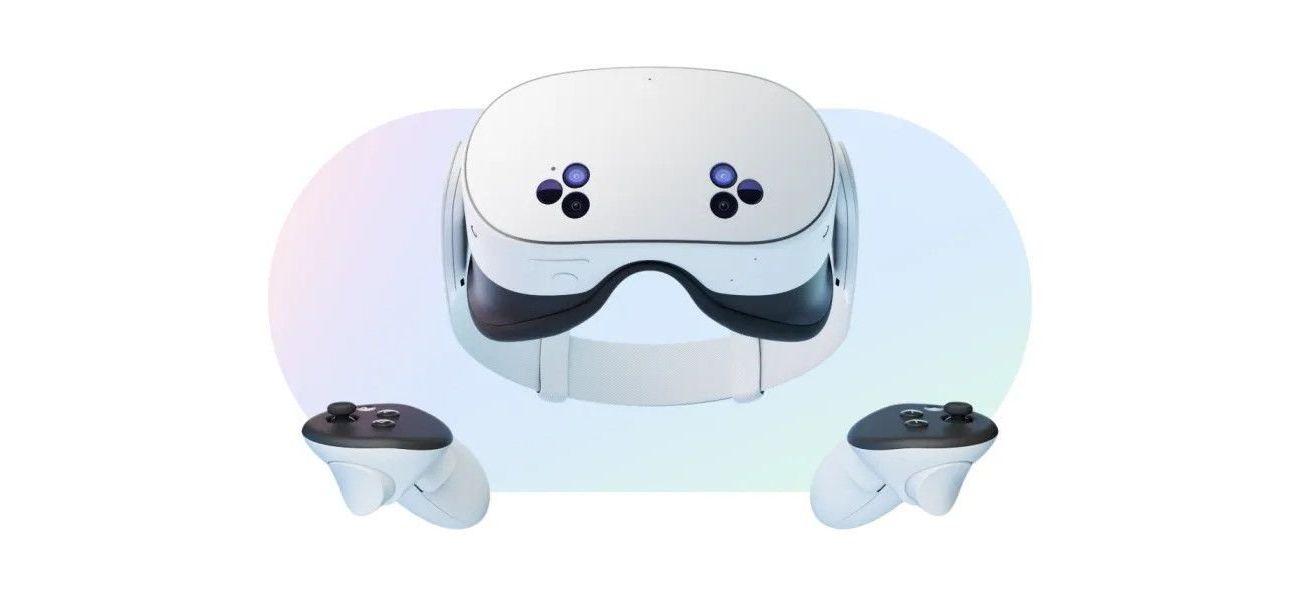Low-priced VR headset with high-end capabilities, Meta Quest 3S is a game-changer.
Is the lower price of the new Meta Quest headset worth the sacrifices it had to make compared to the previous model?
October 22nd 2024.

The latest edition of the Meta Quest, the 3S model, has been making waves in the virtual reality world due to its significantly lower price point compared to its predecessor. But the question on everyone's mind is, does the cheaper cost come with a compromise in quality?
Last year, when we reviewed the Meta Quest 3, we hailed it as the best value VR headset available. And while that was true at the time, its price tag of £480 was still a considerable amount of money. However, the Meta Quest 3 boasted a list of advantages over its competition, such as the fact that it doesn't require a console or PC to function and continues to receive a steady stream of high-quality games.
Today, we'll be reviewing the highly anticipated Batman: Arkham Shadow, just one of the impressive titles in the Meta Quest's game library. With exclusives like Asgard's Wrath 2, Assassin's Creed Nexus, Vader Immortal, The 7th Guest, and even a pre-remake version of Resident Evil 4, it's no wonder that Meta is committed to keeping the platform alive with new releases.
But despite their dedication, the price remains a major hurdle for many. That's where the Meta Quest 3S comes in – a more budget-friendly version of the Quest 3, priced at £379.99 for the 256GB model and £289.99 for the 128GB edition. While still not an impulse purchase, it's a significant drop from the Quest Pro's price tag of £999.99 and can be considered as affordable as modern technology allows.
So, what sets the Meta Quest 3S apart from its predecessor?
As one would expect, the Meta Quest 3S is all about compromise – finding the perfect balance between reducing the price and retaining the features that made the original headset so appealing.
One of the most significant selling points of the Quest 3 was its graphics chip, which remains unchanged in the 3S. However, the lack of connection to an external device, while convenient, means that all graphics have to be generated within the headset itself, using processors similar to those found in smartphones.
The Meta Quest 3S may not be able to compete with the PlayStation 5 in terms of graphics, but it does offer twice the power of the Quest 2, and many games still look stunning, comparable to those on the PlayStation 4.
However, the 3S does have some noticeable differences from the Quest 3 – namely, the lenses. With a resolution of 1832x1920 pixels, the 3S's lenses are noticeably lower than the Quest 3's 2064x2208. Additionally, the 3S only has a single-display system, resulting in slightly blurrier visuals, especially towards the edges of your vision.
The inferior lenses also make the "screen door" effect more noticeable, where it appears as though you're viewing the VR world through a piece of gauze. However, for first-time users, this may not be a significant issue, as these downgrades are less noticeable.
The field of view on the 3S is also narrower than the Quest 3, and it goes back to using three fixed positions to adjust the distance between the lenses for your face and eyes, rather than a dial for manual adjustment. This can make it challenging to get the perfect focus.
Despite being 1 gram lighter than the Quest 3, the 3S is bulkier and sticks out further from the face, making it feel heavier than it actually is.
But what features does the Meta Quest 3S have to offer?
Aside from the differences in lenses, the 3S is mostly identical to the Quest 3. It has a battery life of about three hours and the option to connect it to a PC for access to a wider range of VR games, including the highly acclaimed Half-Life: Alyx.
The controllers are also the same as the Quest 3's, which are considered some of the best in the industry due to their lack of a tracking ring, allowing for less restrictive movements. The 3S does not have a depth sensor, but this seems to have little effect on gameplay, as the default set-up works well in detecting walls and furniture.
The 3S can also run mixed reality apps, blending virtual worlds with the camera's view on the front of the headset. There's also a new button to switch to a view of the real world at any time, although this feature is rarely needed.
The Horizon OS interface, akin to a console's dashboard, is intuitive and attractive, and regularly updated with new VR landscapes to explore while browsing through your options.
The ultimate question remains – is the Meta Quest 3S worth it?
As mentioned earlier, the 3S is all about compromise, and that's reflected in its lower price. While it may not match the quality of the Quest 3 or other comparable headsets, it's still the most affordable option on the market.
Whether or not the compromises are worth it depends on your experience with VR. If you're looking to upgrade from the Quest 2, it may be worth saving up for the Quest 3 instead. But for first-time users, there's no better place to start.
The future of gaming has been in virtual reality for decades, and it's still unclear whether it will become a footnote in history or the endgame for all hardware. But one thing is for sure – the Meta Quest 3S, despite its cost, is the best value VR headset available today.
Don't forget to email us, leave a comment, follow us on Twitter, and sign up for our newsletter for exclusive gaming content, the latest releases, and more. And if you have a letter or feature to submit, use our Submit Stuff page for a hassle-free process.
Sign up for all the latest gaming news and releases before they hit the site – we promise not to spam you. Your privacy is important to us, and this site is protected by reCAPTCHA and the Google Privacy Policy and Terms of Service apply.
Last year, when we reviewed the Meta Quest 3, we hailed it as the best value VR headset available. And while that was true at the time, its price tag of £480 was still a considerable amount of money. However, the Meta Quest 3 boasted a list of advantages over its competition, such as the fact that it doesn't require a console or PC to function and continues to receive a steady stream of high-quality games.
Today, we'll be reviewing the highly anticipated Batman: Arkham Shadow, just one of the impressive titles in the Meta Quest's game library. With exclusives like Asgard's Wrath 2, Assassin's Creed Nexus, Vader Immortal, The 7th Guest, and even a pre-remake version of Resident Evil 4, it's no wonder that Meta is committed to keeping the platform alive with new releases.
But despite their dedication, the price remains a major hurdle for many. That's where the Meta Quest 3S comes in – a more budget-friendly version of the Quest 3, priced at £379.99 for the 256GB model and £289.99 for the 128GB edition. While still not an impulse purchase, it's a significant drop from the Quest Pro's price tag of £999.99 and can be considered as affordable as modern technology allows.
So, what sets the Meta Quest 3S apart from its predecessor?
As one would expect, the Meta Quest 3S is all about compromise – finding the perfect balance between reducing the price and retaining the features that made the original headset so appealing.
One of the most significant selling points of the Quest 3 was its graphics chip, which remains unchanged in the 3S. However, the lack of connection to an external device, while convenient, means that all graphics have to be generated within the headset itself, using processors similar to those found in smartphones.
The Meta Quest 3S may not be able to compete with the PlayStation 5 in terms of graphics, but it does offer twice the power of the Quest 2, and many games still look stunning, comparable to those on the PlayStation 4.
However, the 3S does have some noticeable differences from the Quest 3 – namely, the lenses. With a resolution of 1832x1920 pixels, the 3S's lenses are noticeably lower than the Quest 3's 2064x2208. Additionally, the 3S only has a single-display system, resulting in slightly blurrier visuals, especially towards the edges of your vision.
The inferior lenses also make the "screen door" effect more noticeable, where it appears as though you're viewing the VR world through a piece of gauze. However, for first-time users, this may not be a significant issue, as these downgrades are less noticeable.
The field of view on the 3S is also narrower than the Quest 3, and it goes back to using three fixed positions to adjust the distance between the lenses for your face and eyes, rather than a dial for manual adjustment. This can make it challenging to get the perfect focus.
Despite being 1 gram lighter than the Quest 3, the 3S is bulkier and sticks out further from the face, making it feel heavier than it actually is.
But what features does the Meta Quest 3S have to offer?
Aside from the differences in lenses, the 3S is mostly identical to the Quest 3. It has a battery life of about three hours and the option to connect it to a PC for access to a wider range of VR games, including the highly acclaimed Half-Life: Alyx.
The controllers are also the same as the Quest 3's, which are considered some of the best in the industry due to their lack of a tracking ring, allowing for less restrictive movements. The 3S does not have a depth sensor, but this seems to have little effect on gameplay, as the default set-up works well in detecting walls and furniture.
The 3S can also run mixed reality apps, blending virtual worlds with the camera's view on the front of the headset. There's also a new button to switch to a view of the real world at any time, although this feature is rarely needed.
The Horizon OS interface, akin to a console's dashboard, is intuitive and attractive, and regularly updated with new VR landscapes to explore while browsing through your options.
The ultimate question remains – is the Meta Quest 3S worth it?
As mentioned earlier, the 3S is all about compromise, and that's reflected in its lower price. While it may not match the quality of the Quest 3 or other comparable headsets, it's still the most affordable option on the market.
Whether or not the compromises are worth it depends on your experience with VR. If you're looking to upgrade from the Quest 2, it may be worth saving up for the Quest 3 instead. But for first-time users, there's no better place to start.
The future of gaming has been in virtual reality for decades, and it's still unclear whether it will become a footnote in history or the endgame for all hardware. But one thing is for sure – the Meta Quest 3S, despite its cost, is the best value VR headset available today.
Don't forget to email us, leave a comment, follow us on Twitter, and sign up for our newsletter for exclusive gaming content, the latest releases, and more. And if you have a letter or feature to submit, use our Submit Stuff page for a hassle-free process.
Sign up for all the latest gaming news and releases before they hit the site – we promise not to spam you. Your privacy is important to us, and this site is protected by reCAPTCHA and the Google Privacy Policy and Terms of Service apply.
[This article has been trending online recently and has been generated with AI. Your feed is customized.]
[Generative AI is experimental.]
0
0
Submit Comment





